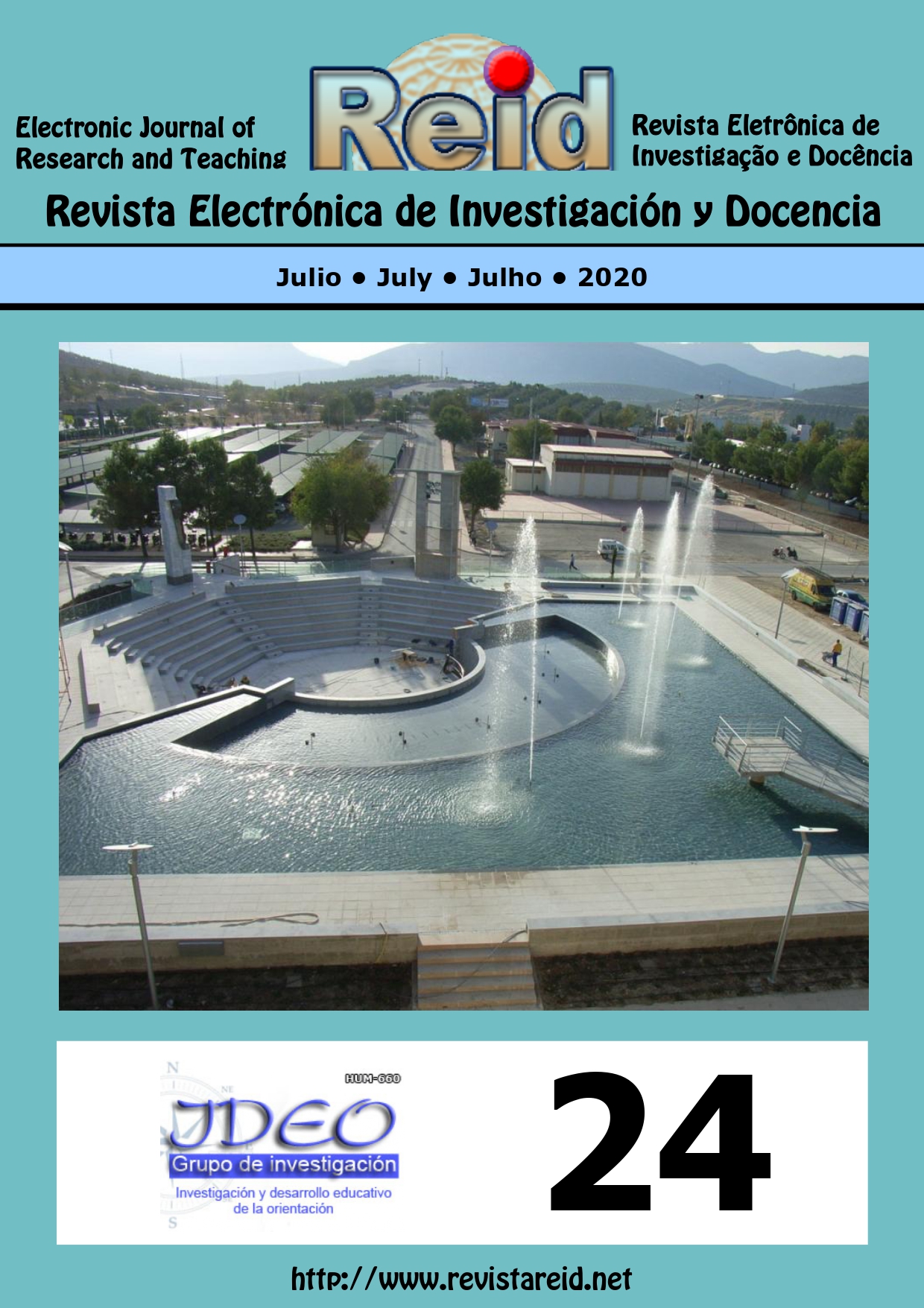Audios y videos cortos auténticos en la percepción de procesos fonológicos: actitudes de estudiantes argentinos universitarios de inglés con nivel intermedio
DOI:
https://doi.org/10.17561/reid.n24.4Palabras clave:
videos cortos auténticos, audios, actitudes, procesos fonológicos, enseñanzaResumen
El presente estudio se enmarca dentro de la tesis doctoral denominada “Efectos de audios y videos cortos auténticos: reconocimiento de procesos fonológicos y actitudes de estudiantes argentinos universitarios de inglés con nivel intermedio”. Este trabajo en particular se centra en las actitudes de los estudiantes hacia audios y videos cortos auténticos en el reconocimiento de procesos fonológicos del inglés hablado. Los sujetos de estudio son estudiantes de la asignatura Fonética y Fonología Inglesa I de las carreras de Profesor y Traductor Público de Inglés en la Facultad de Lenguas (FADEL) de la Universidad Nacional del Comahue (UNCo), Argentina. Se emplea un diseño cuasi-experimental basado en dos grupos: el audiovisual y el audio. El primero (n=32) es expuesto a segmentos de video auténticos para desarrollar la percepción de procesos fonológicos, mientras que el segundo (n=34) es instruido mediante este mismo material, pero sin soporte visual. Los segmentos utilizados son: video musical, preestreno, avisos comerciales, documental, cortometraje y escena de película. Las actitudes del estudiantado se examinan antes y después de la intervención. Para tal fin, se administran un cuestionario informativo y un cuestionario de valoración. Del análisis de los datos se deduce que los estudiantes manifiestan una actitud positiva hacia ambos recursos, siendo más positiva hacia el recurso audiovisual antes y después de la intervención. Se espera seguir explorando los efectos de los distintos tipos de videos breves en la percepción de procesos fonológicos y en otros aspectos de la pronunciación.
Descargas
Referencias
Alameen, G. (2014). The effectiveness of linking instruction on NNS speech perception and production. Disertación doctoral sin publicar. Iowa State University, Ames, USA.
Alameen, G. & Levis, J. M. (2015). Connected speech. En M. Reed & J. M. Levis, (Eds.), The handbook of English pronunciation (pp. 159-174). Malden, MA: John Wiley & Sons.
Arcario, P. (1992). Criteria for selecting video materials. En S. Stempleski & P. Arcario (Eds.), Video in second language teaching: Using, selecting, and producing video for the classroom (pp. 109–121). Alexandria, USA: TESOL Publications.
Bahrani, T. & Sim, T. S. (2012). Audiovisual news, cartoons, and films as sources of authentic language input and language proficiency enhancement. Turkish Online Journal of Educational Technology-TOJET, 11(4), 56–64. Recuperado de http://www.tojet.net/articles/v11i4/1145.pdf.
Bradley, M. (2013). Teaching with film. Vienna, Austria: Stone River Books.
Brown, J. D. & Hilferty, A. (1986). The effectiveness of teaching reduced forms of listening comprehension. RELC Journal, 17(2), 59–70. doi:https://doi.org/10.1177/003368828601700204.
Cahill, J. D. (2006). Teaching reduced interrogative forms to low level EFL students in Japan. En J. D. Brown & K. Kondo-Brown (Eds.), Perspectives on teaching connected speech to second language speakers (pp. 99-125). Honolulu, Hawaii: University of Hawai’i Press.
Celce-Murcia, M., Brinton, D. M. & Goodwin, J. M. (2010). Teaching pronunciation: A course book and reference guide. New York, USA: Cambridge University Press.
Crystal, D. (2008). A dictionary of linguistics and phonetics (6a. ed.). Oxford, UK: Blackwell Publishing.
Dalton, C. & Seidlhofer, B. (1994). Pronunciation. Oxford, UK: Oxford University Press.
Derry, S. J., Sherin, M. G. & Sherin, B. L. (2014). Multimedia learning with video. En R. E. Mayer (Ed.), The Cambridge Handbook of Multimedia Learning (2a. ed., pp. 785-812). New York, USA: Cambridge University Press.
Field, J. (2008). Listening in the language classroom. Cambridge, UK: Cambridge University Press.
Gilmore, A. (2007). Authentic materials and authenticity in foreign language learning. Language teaching, 40(2), 97–118. doi: https://doi.org/10.1017/S0261444807004144.
Grant, L. (2014). Pronunciation myths: Applying second language research to classroom teaching. Michigan, USA: University of Michigan Press.
Hernández Sampieri, R., Fernández Collado, C. y Baptista Lucio, P. (2010). Metodología de la investigación (5a. ed.). DF, México: McGraw Hill.
Ibarrola, A. L. (2011). Imitating English oral texts: A useful tool to learn English Pronunciation? Porta Linguarum: Revista Internacional de Didáctica de las Lenguas Extranjeras, 16, 49–63. Recuperado de: https://digibug.ugr.es/handle/10481/32005.
Joyce, P. (2014). The development and validation of a second language listening reduced forms test. Iranian Journal of Language Teaching Research, 4(2), 155-174. Recuperado de https://www.semanticscholar.org/.
Kaiser, M. (2011). New approaches to exploiting film in the foreign language classroom. L2 Journal, 3(2), 232-249. doi: https://doi.org/ 10.5070/L23210005.
King, J. (2002). Using DVD feature films in the EFL classroom. Computer Assisted Language Learning, 15(5), 509–523. doi: https://doi.org/10.1076/call.15.5.509.13468.
Krashen, S. D. (1985). The input hypothesis: Issues and implications. Harlow, UK: Longman.
Lowe, M. (2007). Films in English language teaching. International House Journal, 23, 16-19. Recuperado de http://ihjournal.com.
MacWilliam, I. (1986). Video and language comprehension. ELT journal, 40(2), 131–135. doi: https://doi.org/10.1093/elt/40.2.131
Massi, M. P. & Blázquez, B. (2008). Exploiting DVDs’ extra features: An added bonus in the EFL class. Humanising Language Teaching (HLT). Free Online EFL Magazine for Teachers, 10(4). Recuperado de http://old.hltmag.co.uk/aug08/mart03.htm.
Massi, M. P. & Blázquez, B. (2010). The shorter the better: Using shorts in ELT. Modern English Teacher, 19(2), 36–42.
Massi, M. P. & Blázquez, B. A. (2012). A short is worth a thousand films! Teaching English with Technology (TEwT). Free Online Journal for TESOL Teachers, 12(3), 62–86. Recuperado de: https://www.tewtjournal.org/issues/past-issue-2012/past-issue-2012-issue-3/.
Mayer, R. E. (2014). Introduction to multimedia learning. En R. E. Mayer (Ed.), The Cambridge handbook of multimedia learning (2.a ed., pp. 1-26). New York, USA: Cambridge University Press.
Mendelsohn, D. (1994). Learning to listen: A strategy-based approach for the second-language learner. San Diego, USA: Dominie Press.
Nunan, D. (1999). Second language teaching & learning. Boston, USA: Heinle & Heinle.
Peacock, M. (1997). The effect of authentic materials on the motivation of EFL learners. ELT Journal, 51(2), 144–156.
Rahimi, M. & Chalak, A. (2017). The effect of connected speech teaching on listening comprehension of Iranian EFL learners. Journal of Applied Linguistics and Language Research, 4(8), 280–291. Recuperado de https://www.semanticscholar.org/.
Roach, P. (2009). English phonetics and phonology: A practical course (4.a ed.). Cambridge, UK: Cambridge University Press.
Rogerson, M. (2006). Don’cha know? A survey of ESL teachers’ perspectives on reduced form instruction. En J. D. Brown & K. Kondo-Brown (Eds.), Perspectives on teaching connected speech to second language speakers. Honolulu, Hawaii: University of Hawai’i Press.
Sherman, J. (2003). Using authentic video in the language classroom. Cambridge, UK: Cambridge University Press.
Snelson, C. & Perkins, R. A. (2009). From silent film to YouTubeTM: Tracing the historical roots of motion picture technologies in education. Journal of Visual Literacy, 28(1), 1–27. doi: https://doi.org/10.1080/23796529.2009.11674657.
Stempleski, S. (2002). Video in the ELT classroom: The role of the teacher. En J. C. Richards & W. A. Renandya, (Eds.), Methodology in language teaching: An anthology of current practice (pp. 354–367). Cambridge, UK: Cambridge University Press.
Stempleski, S. & Tomalin, B. (2001). Film. Oxford, UK: Oxford University Press.
Sweeting, A. (2009). Language through film. Sydney, Australia: Phoenix Education Pty.
Sweller, J. (2005). Implications of cognitive load theory for multimedia learning. En R. E. Mayer (Ed.), The Cambridge handbook of multimedia learning (1.a ed., pp. 19-31). New York, USA: Cambridge University Press.
Taylor, S. (2009). Using Video: Theory. IH Journal, 26. Recuperado de http://ihjournal.com/using-video-theory
Underwood, P. & Wallace, M. (2012). The effects of instruction in reduced forms on the performance of low-proficiency EFL university students. The Asian EFL Journal, 14(4), 1–24. Recuperado de https://www.researchgate.net/publication/286007702
Wagner, E. (2007). Are they watching? Test-taker viewing behavior during an L2 video listening test. Language Learning and Technology, 11(1), 67-86. doi: http://dx.doi.org/10125/44089
Walker, C. (1999). Teacher’s guide to using film and TV. London, UK: Penguin Longman.
Wang, Y. T. (2005). An exploration of the effects of reduced forms instruction on EFL college students’ listening comprehension. Tesis de maestría sin publicar. National Tsing Hua University, Hsinchu, Taiwan.
Wong, S., Mok, P., Kien-Hoa Chung, K., Leung, V., Bishop, D. & Chow, B. (2017). Perception of native English reduced forms in Chinese learners: Its role in listening comprehension and its phonological correlates. TESOL Quarterly, 51(1), 7-31. doi: https://doi.org/10.1002/tesq.273
Yang, L. (2016). Optimizing pronunciation and prosody teaching in second language learning. Conferencia impartida en International Symposium on Applied Phonetics, Nagoya, Japan. Recuperado de: https://www.researchgate.net/publication/315770663
Yoshida, M. T. (2016). Beyond repeat after me: Teaching pronunciation to English learners. Alexandria, USA: TESOL Press.
Descargas
Publicado
Número
Sección
Licencia
Los autores que publiquen en esta revista aceptan que los derechos de impresión y de reproducción por cualquier forma y medio serán propiedad de REID.
REID aceptará cualquier petición razonable que se haga para obtener el permiso de acceso y en su caso, de reproducción de los artículos ya publicados.
Declaración de privacidad
Los nombres y direcciones de correo electrónico introducidos se usarán exclusivamente para los fines declarados por esta revista y no estarán disponibles para ningún otro propósito u otra persona.










